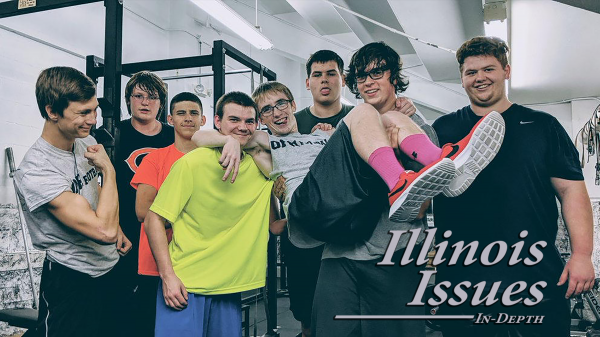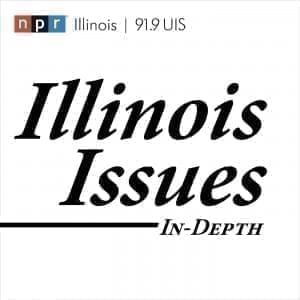Illinois Issues: What Stops School Consolidation?

Athletes from three school districts — Hutsonville CUSD1, Palestine CUSD3, and Oblong CUSD4 — merged in fall 2018 to field a single football team. Meanwhile, their school districts remain separate. Mark Ambrose
Illinois has 852 school districts — the third highest number of any state in the nation. Some are just single schools, with fewer than a hundred students. But getting districts to merge, or consolidate, has proven difficult.
Last summer, Mark Ambrose became head coach of a new football team. At the first practice, Coach Ambrose set the tone by sitting down in the middle of the floor.
“And I’m a 240-pound guy,” he says. “Then I had like a guy from Oblong try to pick me up, who really struggled to do it, then I had another guy try to pick me up, you know, kinda with him …”
Finally, Ambrose called over a third athlete.
“And all three could easily pick me up,” he says. “I just used that as an example that they were stronger together.”
“Stronger Together” became the team’s motto — featured on T-shirts, chanted by cheerleaders, crafted into a banner by kindergartners. It was crucial, Ambrose says, because the team was a new co-op merging athletes from three east central Illinois high schools — Palestine, Hutsonville, and Oblong.
The team started workouts just a few months after two of those towns — Palestine and Hutsonville — attempted to carry their merger beyond sports by asking voters to approve consolidation of their school districts.
“The first time I visited Palestine, I remember seeing a billboard that was specifically saying Vote NO,” Ambrose says.
Alia Blackburn, a reporter with WTHI (the CBS affiliate in nearby Terre Haute, Indiana) says residents were “extremely emotional” about the vote. It was preceded by a series of townhall meetings, which Blackburn covered. She says every one of them was packed.

Alia Blackburn
“You could tell by the passion in their voices and the expressions on their faces, their body language, that this is something they deeply care about,” she says.
But even though the towns are less than nine miles apart, with a total of only 750 students between them, voters decided by a count of 494 to 317 their school districts were stronger apart.
This scenario isn’t uncommon in Illinois. With 852 districts — some with a single school, enrolling fewer than 100 students — consolidation comes up and gets voted down a lot, despite the having supporters in both political parties. In fact, two different think tanks — the Better Government Association and the conservative Illinois Policy Institute — have advocated for more districts to consolidate.
IPI says consolidation would cut taxes by reducing the number of school superintendents who get high salaries and fat pensions. BGA points to the stability in academic programs that could come from a more robust pool of teachers.
So what’s the problem?
Legend has it that consolidation fails because nobody wants to lose their mascot. But plenty of schools co-op sports, like Ambrose’s “OPH” football team, and manage to compromise on the mascot
Money can be a big sticking point, especially if one district has debt or pays their teachers and staff higher wages.
State Sen. Chapin Rose (R-Mahomet) suggests it’s the math of mileage.
“I believe there’s a lot of districts out there that want to explore consolidation,” he says, “but once they find out that their kids are going to be on a bus, driving for hours in one direction, it kind of ends the conversation.”
He’s pitching a plan (SB 1369) that would allow any elementary district to dissolve and disperse its students among multiple neighboring districts (right now, they have to pick just one). His plan got a green light in a preliminary hearing when he told lawmakers about a school he represents.
“You have a school district that is having a helluva time operating with 80 kids K-8. Eighty kids K-8,” he said.

Mark Ambrose made sure to incorporate all three high school's colors in this logo for the Oblong, Palestine-Hutsonville co-op football team he coaches.
Another measure (HB 3053), sponsored by State Rep. Rita Mayfield (D-Waukegan), would form a commission to see which districts could save money by consolidating, then give taxpayers the chance to vote. The Senate version (SB 1838) of that measure would limit it to so-called non-unit districts, like the one Rose described — districts that only go up to 8th grade, and districts that serve only grades nine through 12. Most of our state’s school districts fall into this category.
For now, small districts will continue creatively combining special ed services, sometimes food purchases, and of course sports teams.
Coach Ambrose’s team won more games in its first season than either Palestine-Hutsonville (which had been co-opping for a while) or Oblong had won the previous year.

“We won three games,” Ambrose says. “I had many guys who had never won a football game the whole time they’d ever played football. They just worked well together.”
Illinois Issues is in-depth reporting and analysis that takes you beyond the headlines to provide a deeper understanding of our state. Illinois Issues is produced by NPR Illinois in Springfield.

